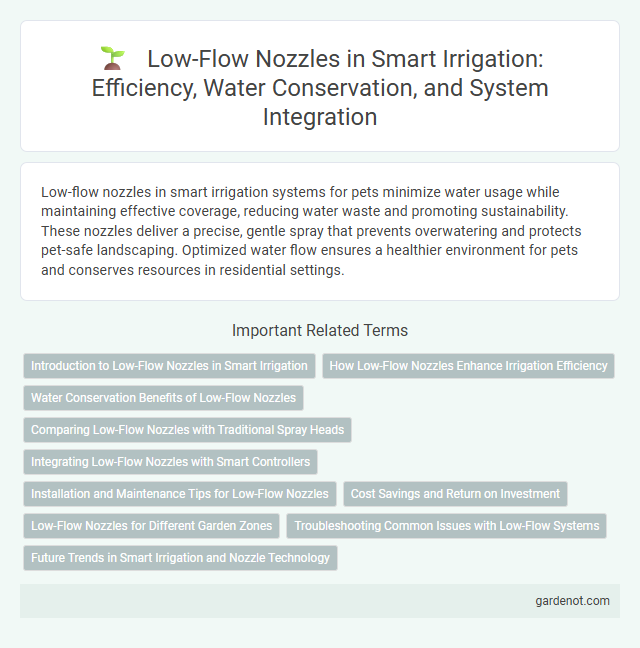Low-flow nozzles in smart irrigation systems for pets minimize water usage while maintaining effective coverage, reducing water waste and promoting sustainability. These nozzles deliver a precise, gentle spray that prevents overwatering and protects pet-safe landscaping. Optimized water flow ensures a healthier environment for pets and conserves resources in residential settings.
Introduction to Low-Flow Nozzles in Smart Irrigation
Low-flow nozzles in smart irrigation systems deliver water at reduced rates, enhancing water efficiency and minimizing runoff. These nozzles optimize watering schedules by matching irrigation output with plant water requirements, significantly conserving water resources. Integration with smart controllers enables precise control, promoting sustainable landscape management.
How Low-Flow Nozzles Enhance Irrigation Efficiency
Low-flow nozzles enhance irrigation efficiency by delivering water at a reduced rate, minimizing runoff and ensuring deep soil absorption. Their precise water distribution targets plant roots directly, optimizing water usage and reducing waste. This technology supports sustainable landscape management by conserving water while maintaining healthy plant growth.
Water Conservation Benefits of Low-Flow Nozzles
Low-flow nozzles significantly reduce water usage by delivering precise, controlled irrigation tailored to plant needs, minimizing runoff and evaporation. These nozzles enhance water conservation efforts by maintaining optimal soil moisture levels with less water volume. Implementing low-flow technology supports sustainable landscaping and lowers overall irrigation costs while preserving vital water resources.
Comparing Low-Flow Nozzles with Traditional Spray Heads
Low-flow nozzles significantly reduce water usage compared to traditional spray heads by delivering water at rates typically between 0.1 to 0.5 gallons per minute, whereas traditional heads often exceed 2 gallons per minute. These nozzles enhance irrigation efficiency by providing uniform water distribution with less runoff and evaporation, making them ideal for smart irrigation systems targeting water conservation. Studies show that switching to low-flow nozzles can decrease overall water consumption by up to 50% without sacrificing turf health or landscape aesthetics.
Integrating Low-Flow Nozzles with Smart Controllers
Integrating low-flow nozzles with smart controllers enhances water efficiency by delivering precise irrigation tailored to real-time soil moisture and weather conditions. Smart controllers optimize irrigation schedules, reducing water waste and promoting healthier plant growth through targeted low-flow applications. This combination supports sustainable water management by maximizing coverage while minimizing runoff and evaporation losses.
Installation and Maintenance Tips for Low-Flow Nozzles
Low-flow nozzles should be installed ensuring even spacing to optimize water distribution and reduce runoff, typically positioned 12-18 inches apart in sprinkler heads. Regular maintenance involves inspecting for clogs or debris buildup and cleaning with mild water pressure or soaking in vinegar to restore water flow. Routine checks during seasons and after heavy use help maintain efficiency and prolong nozzle lifespan in smart irrigation systems.
Cost Savings and Return on Investment
Low-flow nozzles significantly reduce water consumption by delivering precise irrigation, resulting in lower utility bills and operational costs. Their efficient water use minimizes waste, enhancing overall cost savings while promoting sustainable landscaping practices. Investing in low-flow nozzles offers a rapid return on investment through decreased water expenses and prolonged system longevity.
Low-Flow Nozzles for Different Garden Zones
Low-flow nozzles optimize water efficiency by delivering precise, reduced flow rates tailored to specific garden zones such as flower beds, vegetable patches, and lawns. These nozzles minimize runoff and water waste by matching irrigation output to the soil's absorption rate and plant water requirements. Integrating zone-specific low-flow nozzles enhances smart irrigation systems by promoting sustainable water conservation and healthier plant growth.
Troubleshooting Common Issues with Low-Flow Systems
Low-flow nozzle systems often face issues such as clogging due to mineral deposits or debris, which can reduce water output and coverage. Regular maintenance, including flushing nozzles and using inline filters, helps maintain optimal flow and prevent blockages. Adjusting pressure regulators ensures consistent water delivery, improving system efficiency and preventing uneven irrigation.
Future Trends in Smart Irrigation and Nozzle Technology
Low-flow nozzles in smart irrigation systems enhance water efficiency by delivering precise amounts of water, reducing runoff and evaporation. Future trends indicate integration with AI-driven sensors for real-time soil moisture analysis, enabling adaptive water delivery based on specific plant needs. Advancements in nozzle materials and design will further optimize droplet size and distribution, promoting sustainable agricultural practices.
Low-flow nozzle Infographic

 gardenot.com
gardenot.com